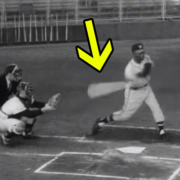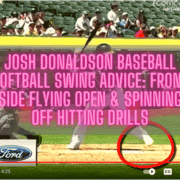Fun Youth How To Teach No Stride Length, Toe Tap, And Leg Kick Hitting Tips For Beginner Baseball & Softball Swing | Where Does Front Foot Land, And When, Hit Drills For 6 To 10 Year Olds
Fun youth how to teach a no stride, toe tap, and leg kick hitting tips for beginner baseball and softball swing. Hit drills for 6 to 10 years old questions ANSWERED: Where does front foot land, when to stride, and what is the stride length?
Baseball Batting Techniques: Simple Way To Use Forward Momentum That Works For Elite Hitters
In this baseball batting techniques post, we’ll talk about how elite MLB sluggers employ Forward Momentum (FoMo for short).
I’m going to answer the following questions from my readers:
- Does a hitter transfer all their weight to the front leg at some point in the swing?
- Does FoMo stride need to be big or small?
- Does the back foot “follow” the front with FoMo?
- Can a wide no-stride hitter utilize Forward Momentum?
- Are FoMo hitters more vulnerable to off speed and breaking stuff?
Keep in mind, forward momentum is the objective, and in this baseball batting techniques post, I’ll show different elite hitter examples of forward momentum. The important thing isn’t what you use to get Forward Momentum, it’s the Forward Momentum itself.
Let’s get to it…
Does a hitter transfer all their weight to the front leg at some point in the swing?
Yes. With elite sluggers, it’s rare you don’t find them shifting their weight from back to forward. We typically see one of a few baseball batting techniques associated with FoMo: 1) a “Float”, or a slight weight shift back, then 2) a “Free Fall” forward.
And FYI during the Float, yes it’s okay for the back knee to drift over the foot, and NOT have to unnaturally be ‘shoved’ inside it.
You’ll see the following hitters, who try and start with the back knee inside the back foot (Jose Bautista), will accidently float the knee back out before falling forward.
The dead give away of elite hitters shifting their weight is to look at the weight distribution at impact. You’ll see a weight-free back leg at the start of the turning pelvis…
Andrew “Cutch” McCutchen
Troy “Tulo” Tulowitzki
Jose “Joey Bats” Bautista
SCIENCE-BASED TRAINING:
Improve your hitting strategy dramatically by applying human movement principles.
Learn not only how and what to train but also the science behind the methods.
Does FoMo stride need to be big or small?
Whatever the hitter is comfortable with. In other words, don’t be so specific in teaching certain Forward Momentum baseball hitting techniques. Remember, the objective is that they’re employing Forward Momentum. We don’t really care how they get there.
Feel free to recommend your hitters tinker with and test the following FOUR stride types:
Josh “The Bringer of Rain” Donaldson (BIG Leg Kick)
Dustin “Laser Show” Pedroia (MEDIUM Leg Kick)
Robinson “Mercedes” Cano (SMALL Leg Kick/Slide Step)
Victor Martinez (Toe Tap)
Does the back foot “follow” the front with FoMo?
It doesn’t have to, but I like it too. If a hitter gets too wide with the stride, and the back foot isn’t allowed to follow, then the hitter will have a challenge getting a tight back knee angle, which is responsible for a better ball launch angle. CLICK HERE for the back knee angle Zepp experiment.
Roberto “The Great One” Clemente (watch at the 0:33 mark and beyond)
Mike “Millville Meteor” Trout
Bryce “Bam Bam” Harper
CLICK HERE for one of my favorite baseball batting techniques, the Back Foot Variance Drill.
Can a wide no-stride hitter utilize Forward Momentum?
Here are my questions for a coach who would ask this about baseball batting techniques:
- “Why are you hooked on being so wide with the feet at the start, and/or not allowing a stride?…”
- “Is it about minimizing head movement?”
- “Is it cutting down on moving parts?”
- “Is it a timing thing?”
Coaches on Facebook have told me, the stride is too hard to teach, or for a young hitter to get. Apparently this poison was shared during a speech at the American Baseball Coaches Association (ABCA) conference.
I’m not convinced, especially when 3-year-old Chinese females are learning some of the most complex human movements in Gymnastics.
Furthermore,
Look to other explosive athletes that almost NEVER start wide with their feet:
- Pitchers,
- Olympic Divers,
- Olympic Throwers,
- Soccer Players,
- Quarterbacks, Linebackers, and Deep Backs…
Sometimes, it’s not about choosing particular baseball batting techniques. It’s a mindset. I always stress to my hitters, get athletic from the start, and be athletic when you land, so you can transfer the max amount of energy from your body, into the barrel, then to the ball.
About head movement, it’s going to happen. CLICK HERE for a compelling baseball batting techniques analysis by Dan Farnsworth at FanGraphs.com, that demystifies that elite hitters are keeping their head still (Read under “Keep Your Head Still” section).
If it’s about timing, then it’s the timing that must be adjusted. There are only two timing elements:
- When the hitter starts their swing, and
- How long they ‘Float’.
A hitter can change one or the other, or both. It’s up to them.
Those are the adjustments, it’s not a “stride issue”. CLICK HERE for my favorite baseball batting techniques for timing.
Even big guys use Forward Momentum. It just looks more subtle…coming in the form of a ‘sliding’ of the pelvis (Cruz and Pujols are great examples of this below)…
Miguel “Miggy” Cabrera
Nelson “Boomstick” Cruz
Albert “The Machine” Pujols
Are FoMo hitters more vulnerable to off speed and breaking stuff?
This is common issue #2 that coaches have with Forward Momentum, a hitter cannot adjust to breaking or off-speed stuff.
I invite you to look at the following sluggers who use FoMo, and their stats don’t reveal they had trouble adjusting to off speed and breaking stuff:
All these hitters had exceptional power, high averages, low strikeouts, and high walks compared to today’s hitters.
Last but certainly not least…
David “Big Papi” Ortiz
And how about Big Papi? Why wouldn’t we mention him, right?! He just hit his 500th career homer! He starts and finishes in the same spot, but there’s a whole lot of FoMo going on in-between:
In Conclusion
When it comes to baseball batting techniques, Forward Momentum is the objective. How we get our hitters there doesn’t really matter. Just give them examples of how to accomplish more FoMo, and allow them to tinker and test until they find something they’re comfortable with doing.
CLICK HERE to Enter for a chance to Win one free account access to The Truth About Explosive Rotational Power online video course (a $77 value). You have until 12:00pm PST today to enter. To better your chances of winning, you can spread the word on social media. I’ll be picking the winner Monday, September 21st, and reaching out via email. Good luck! 😀
Contest UPDATE: this contest is now closed, and Jon Ball was our winner!
- Fix Late Swings Fast: 2025 Pitch Recognition & See-Decide-Swing Training for Youth Baseball Power Hitters - October 6, 2025
- Safe Youth Weighted Bat Training: Proven Overload/Underload Drills to Increase Exit Velocity in Games Starting Tonight - September 29, 2025
- AI Coaching Course 2025: Youth Baseball & Softball Practice Plan + Off-Season & In-Season Workout Builder Fast - September 23, 2025














What does it mean that the back foot follows?
Jeff, I call it “skipping the back foot”. Watch most of the videos, and pay particular attention to the back foot during the swing. You’ll see it ‘follow’ the front during the the Final Turn.
Another thorough job, Joey! Is there anything left to say about this?
Haha, thanks Joe. A lot of questions about FoMo, so I wanted to give a definitive guide. And I figured you’d appreciate the back foot “follow” question 😀
Joey,
Even Albert Pujols is back to striding. Look at David Wright. Is the decline in his power production attributable to his no stride/no follow up foot skip swing?
Joe, I think a combination of things. One thing in particular is the chronic injuries he’s seemed to develop over the past 5 years. FoMo makes everything easier.
Got to get the forces of nature work g for you and not against you. Great slow motion shot of McCutcheon skipping the back foot last Sunday vs. the Cubs.
You got it Joe…swim downstream, not up. Cutch is a beast!
Would a hitter be more likely to skip the back foot on a high pitch rather than a low pitch?
Just saw Pujols hit a HR vs. Cole Hamels. He was back to striding and skipped the back foot as well.
Joe, not sure skipping with high v. low pitches. Would have to watch a lot of film to see the truth in that. I teach skipping no matter what pitch. Simplify. I think Pujols strides with 0 or 1 strike, but not on 2-strikes though. I could be wrong there, but his stride is still very minimal to me, compared to his almost equally big teammate Mike Trout.
Don’t know if anyone caught Carlos Gomez’s HR against the Yankees in the wild card game last night. His mechanics are as good as it gets, from fomo to angular momentum to arm position on the final turn to the back
foot skip, all every thing this arice discusses..
You’re absolutely correct Joe, and he’s a biggin’ too!
Text book, right out of ” The Truth About Explosive Rotational Power. ” But Gomez last night might be the prototype.
I agree Joe, totally.
Didn’t realize that Carlos Gomez is 6-3, 220.
It’s scary when big sluggers adopts these human movement principles.
Joey, don’t you think that the teaching of the stride to younger players is a concern to coaches because they don’t understand that the hands are kept back by showing the numbers to pitcher (spring loaded)? The fallacy in hitting is that the weight is the part that keeps hands back to adjust to off speed pitches. If that was understood then I believe that it is really easy to teach to anybody no matter the age.
Mike, yes we as instructors are continually fighting conventional wisdom which is the majority philosophy these days. “Sitting back” destroys hitters from being aggressive. Footwork is one of the first things I teach my hitters, then I move on to the Catapult Loading System. I do this because involves re-calibrating the timing. And the latter being of most importance. Once my hitters get to showing the numbers, they really start dropping the hammer, and is where my 60-lb hitters are hitting the ball with 64-mph of Ball Exit Speed, OR my 98-lb’er hitting the ball consistently over 300-feet.
I really wish you would include more fast pitch examples. I have your program and have been working with my daughter. Her mechanics are improving but we encounter so much resistance from coaches. Having good fast pitch examples would help educate her more clearly. Thank you.
Arnold, great point!!! This particular article wasn’t geared for fastpitch per se, but YOU ARE in luck because I’m moving my fastpitch hitters to use something similar to what Lauren Chamberlain does in the following video:
She’s using what I call ‘shifting foot pressure’. I’m moving my girls to this because of the difference in pitching distance and reaction time required for fastpitch. This shifting foot pressure still gets the job done, while staying within the guidelines of forward momentum. This is what golfers use.
And to be clear about the shifting foot pressure, check out this post I did on Mickey Mantle:
http://gohpl.com/1k6T6GX
I did an experiment with 2 students hitting off of a tee using no stride, and about a 6″stride. They were 2 sisters with pretty solid swings but no forward movement.
I tracked their ball exit speeds using both swings. The stride swing averaged about 5-6 mph faster than the no stride no fomo swing!
Awesome experiment Boyd!! And results…
Now let me ask you a few questions about it:
Sorry for all the questions, but I’ve received A LOT of flack from the ‘peanut’ gallery about my first swing experiments. So I’ve learned and made them better. By the way, I did a post showing exactly how I run my swing experiments, if it helps:
http://gohpl.com/1IA3EWT
Just because there is no weight on the back foot does not mean that all of the weight is on the front foot. It is absolutely clear that the center of mass is still between the two feet. They are just in an unstable position at the moment of contact with a fraction of their weight (less than 100 percent) on the front foot and the rest unsupported between the feet. So, forward momentum is a thing, but it’s only going about half as far as you propose. All of your videos show it if you look carefully. The center of mass is not above the front foot in a stable position at the moment of contact, it is somewhere in between the two feet.
Michael, a hitter’s weight and center of mass are two different things. Yes, center mass is behind the front leg with most elite hitters, however their back leg is ‘weightless’, evidenced by ‘no weight’ showing on the back foot. Look, we’re talking about transferring forward momentum, the hitter’s weight has to come off the back leg because we’re moving dynamically. Sounds like we’re describing the same thing but in different language, with the premium on defining terms.